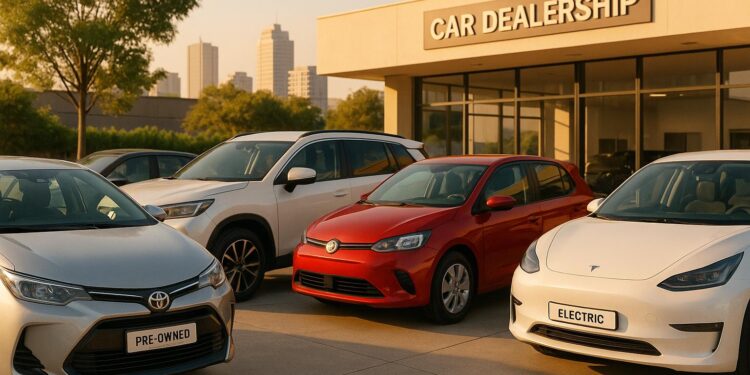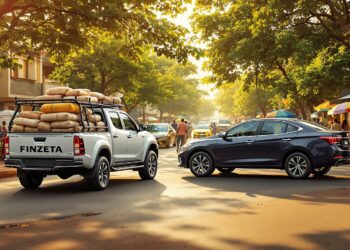In 2025, buying a car in Tanzania depends on your budget and priorities. Here’s a quick breakdown of the market:
- Second-hand cars: The most affordable choice for most buyers. Japanese brands dominate, offering reliability at lower costs. Options range from budget-friendly older models to premium used cars for those seeking comfort and status. Maintenance and fuel efficiency make them cost-effective, but buyers should factor in ongoing expenses like repairs and insurance.
- New cars: These are pricier but offer modern features, warranties, and reliability. Popular brands like Toyota and Hyundai cater to middle- and high-income buyers. Financing options make them more accessible, but higher insurance and depreciation are key considerations.
- Electric vehicles (EVs): EVs are gaining interest, especially among eco-conscious and wealthier buyers. While upfront costs are higher, government incentives and lower fuel/maintenance costs are making them more appealing. Limited charging infrastructure and availability are challenges.
Quick Comparison
| Factor | Second-Hand Cars | New Cars | Electric Vehicles (EVs) |
|---|---|---|---|
| Price Range | Lower | Higher | Highest |
| Availability | Wide | Readily available | Limited to cities |
| Cost of Ownership | Variable, lower upfront | Predictable, higher | Lower fuel, higher upfront |
| Target Buyers | Budget-conscious | Middle/high-income | Higher-income, eco-focused |
Each option has trade-offs. Second-hand cars dominate for affordability, new cars offer peace of mind, and EVs are emerging as a long-term investment. Choose based on your financial situation and priorities.
Used Cars form Japan – These 5 Cars RULE Africa in 2025!
1. Second-Hand Cars
For many in Tanzania, buying a second-hand car is the first step toward vehicle ownership. However, shifting import regulations and fluctuating currency values are playing a big role in shaping the market in 2025. These factors influence not just pricing but also availability, ultimately affecting what buyers can afford and choose.
Price Range
The second-hand car market caters to a wide range of budgets. For those looking to save, older models from trusted Japanese brands are often the go-to choice, offering dependable performance at a lower cost. Mid-range buyers can find vehicles that strike a balance between price and features, such as better safety systems and air conditioning. On the other hand, those seeking a bit of luxury or advanced technology can explore premium used cars, which come with added comfort and a touch of prestige.
Availability
Since Tanzania relies heavily on car imports, availability often mirrors trends in international shipping and trade. Japanese vehicles dominate the market, with regular shipments arriving through major ports. Urban areas generally have more options, while rural buyers may face fewer choices and higher transportation costs. Local dealerships and individual sellers also contribute to the market, but their inventories can depend on shipping schedules and seasonal demand.
Suitability for Income Groups
The second-hand car market in Tanzania offers something for nearly every income level. For budget-conscious buyers, the focus is on reliable, no-frills transportation. Middle-income families often seek vehicles with added features like extra seating or enhanced safety. Meanwhile, wealthier buyers tend to lean toward high-end models that provide greater comfort, advanced technology, and a sense of status. This range of options highlights the market’s ability to meet the needs of different financial groups in 2025.
Cost of Ownership
Owning a car goes beyond just the initial purchase price – it’s the ongoing costs that matter, too. Maintenance, fuel efficiency, and insurance premiums are all key factors to consider. Older models are generally cheaper to maintain and more fuel-efficient, making them appealing to cost-conscious buyers. In contrast, premium vehicles often come with higher servicing fees. Insurance costs are typically tied to the car’s market value, and buyers should also budget for registration and inspection fees as part of the total cost of ownership.
2. New Cars
Buying a new car in Tanzania is a significant decision, offering the latest technology and reliable performance. For 2025, the new car market provides options that cater to buyers looking for modern features and peace of mind. Below, we’ll explore pricing, availability, income considerations, and ownership costs for new vehicles in Tanzania.
Price Range
The price of new cars in Tanzania varies widely based on the brand and features. Entry-level models from brands like Suzuki and Hyundai are budget-friendly and come with the basics. Mid-range options, such as those from Toyota and Nissan, focus on blending comfort, fuel efficiency, and technology. On the other hand, luxury SUVs and premium vehicles stand at the higher end of the spectrum, with their prices reflecting advanced features and higher import duties.
Availability
Access to new cars in Tanzania depends heavily on authorized dealerships and their partnerships with manufacturers. For instance, Toyota’s robust dealership network ensures a steady supply of popular models like the Corolla and RAV4. Similarly, brands like Nissan, Hyundai, and Mitsubishi maintain consistent inventories through their official dealers. However, occasional supply chain issues can affect the availability of certain trims or colors, and customized models may take longer to arrive.
Suitability for Income Groups
New cars are generally aimed at Tanzania’s higher-income earners. Purchasing one often requires a significant upfront payment or dependable financing options. These vehicles appeal to buyers who prioritize safety, long-term savings, and social status. Business owners and professionals often choose new cars to enhance their image and take advantage of potential tax benefits. Government officials and corporate executives also prefer models that reflect their positions and provide reliable transportation.
Cost of Ownership
New cars come with perks like comprehensive warranties and better fuel efficiency, which help reduce repair and fuel expenses. However, they also bring higher costs for insurance and regular servicing, which buyers should factor into their budgets.
sbb-itb-d9186c2
3. Electric Vehicles
Electric vehicles (EVs) are starting to make their way into Tanzania’s automotive market, reflecting the global shift toward more sustainable transportation. While they bring a unique set of benefits and challenges, their adoption in Tanzania is still in its infancy. If you’re considering an EV, there are a few key factors to keep in mind.
Price Range
EVs tend to come with a higher price tag compared to traditional vehicles. This is largely due to their advanced technology and the costs associated with importing them, such as tariffs and taxes. While there are some entry-level models, mid-range and luxury options are significantly more expensive.
Availability
The EV market in Tanzania is still small, with only a handful of authorized dealers offering these vehicles. Many models need to be specially ordered, and they are primarily available in major cities where charging infrastructure is starting to take shape.
Suitability for Income Groups
Given their higher upfront costs and the limited availability of charging stations, EVs are currently more practical for higher-income individuals. These buyers are often better equipped to afford home charging setups and handle the additional expenses involved.
Cost of Ownership
While EVs can save money on fuel over time, the initial investment is steep. On top of the purchase price, owners face higher insurance premiums, potential battery replacement costs, uncertain maintenance expenses, and the need for a home charging system – all of which contribute to a higher overall cost of ownership.
Pros and Cons
When it comes to choosing a vehicle, each option comes with its own set of benefits and challenges, depending on your budget and driving needs.
Second-hand cars are a great way to get behind the wheel without breaking the bank. They come with the advantage of avoiding that steep initial depreciation, which can make them a better value over time. On the flip side, buyers should be cautious about potential maintenance problems and the uncertainty of the vehicle’s history.
New cars, on the other hand, come with perks like full warranties, the latest safety features, and improved fuel efficiency. Plus, there’s no guesswork about prior ownership. Financing options are often more flexible too. The downsides? They generally demand a higher upfront cost, depreciate quickly after purchase, and can lead to higher ongoing expenses, like insurance.
Electric vehicles are the future of driving, offering savings on energy costs and reducing your carbon footprint. But they come with their own hurdles – higher initial prices, limited charging infrastructure in some areas, and concerns about the cost of replacing batteries down the road.
Here’s a quick comparison to help you weigh your options:
| Factor | Second-Hand Cars | New Cars | Electric Vehicles |
|---|---|---|---|
| Price Range | Lower purchase cost | Higher initial investment | Higher upfront cost |
| Availability | Widely available | Readily available | More limited, especially outside major cities |
| Total Cost of Ownership | Variable, influenced by maintenance | More predictable with warranty coverage | Lower operating costs may offset entry costs |
| Suitable for Income Groups | Often more accessible for tighter budgets | Generally suited for moderate budgets | Typically more viable for higher budgets |
| Financing Options | Fewer options; cash transactions are common | Multiple financing options | May require specialized financing |
Choosing the right vehicle means balancing your immediate budget with long-term costs and your specific transportation needs, especially in Tanzania’s evolving automotive landscape.
Conclusion
Tanzania’s automotive market in 2025 offers a wide range of options, catering to various budgets and preferences.
Second-hand cars dominate the market and remain the most accessible option for many buyers. The used car market is expected to grow from $990 million in 2024 to $1.05 billion in 2025, eventually reaching $1.89 billion by 2035, with an annual growth rate of 6.04%. These vehicles are especially appealing to budget-conscious buyers, providing affordable mobility without the steep depreciation associated with new cars.
Meanwhile, electric vehicles (EVs) are carving out a promising future despite their higher upfront costs. With over 5,000 EVs already on Tanzanian roads, the market is projected to surge from $40 million in 2025 to $220 million by 2030, growing at an impressive 40.5% annually. EVs offer significant savings, with fuel costs reduced by up to 86% and maintenance costs cut by 50% compared to traditional gas-powered cars. Recent government incentives, such as eliminating import duties on unassembled hybrids and waiving excise taxes on EVs, have lowered landed costs by up to 28%, making EVs a more appealing choice.
For those seeking the latest technology and full warranties, new cars remain an attractive option, though they cater to a smaller, higher-income segment. With annual light vehicle sales below 3,000 units, new cars appeal to buyers who prioritize reliability and modern features over cost savings.
In this shifting landscape, second-hand cars remain the go-to option for budget buyers, while EVs are increasingly appealing to middle-income buyers, aligning with the government’s goal of 5% new EV sales by 2030. For higher-income buyers, new vehicles or premium EVs offer long-term value and cutting-edge technology.
The Tanzanian automotive market is evolving rapidly, with battery-electric models in the used car segment expected to grow at a 20.29% annual rate through 2030. As the market transforms, smart buyers are focusing on the total cost of ownership, balancing upfront expenses with long-term savings to make informed decisions in this dynamic environment.
FAQs
What should I think about when choosing between a new or used car in Tanzania?
When choosing between a new or used car in Tanzania, it’s essential to consider factors like cost, availability, and long-term value. Used cars are generally more affordable and easier to find, which makes them a go-to option for many buyers. That said, their maintenance costs can vary widely depending on factors like age, mileage, and overall condition.
On the other hand, new cars come with a higher price tag but often include perks like warranties, reduced repair expenses, and better fuel efficiency. If you frequently drive or tackle Tanzania’s rural roads, a new car might handle those conditions more effectively. Ultimately, your decision should align with your budget, driving habits, insurance expenses, and the car’s dependability.
What is the Tanzanian government doing to encourage the use of electric vehicles, and are there any incentives available?
The Tanzanian government is making a strong push to encourage the use of electric vehicles (EVs) by introducing full exemptions on VAT and customs duties. This move can cut the cost of EVs by as much as 25%, making them a more appealing option for potential buyers. On top of that, import duties on EVs have been reduced, further lowering the financial barrier for those considering the switch.
To complement these measures, efforts are underway to expand charging infrastructure throughout the country. By ensuring EV owners have reliable access to charging facilities, the government aims to make EV adoption more practical and convenient. These initiatives reflect a larger commitment to promoting cleaner, more sustainable transportation options in Tanzania.
What are the long-term costs of owning an electric vehicle versus a gas-powered car in Tanzania?
Owning an electric vehicle (EV) in Tanzania offers the potential for substantial savings over time. One of the biggest advantages is the lower fuel costs – electricity is significantly cheaper than gasoline. Additionally, EVs come with reduced maintenance expenses because they have fewer moving parts compared to traditional gas-powered vehicles.
Although the upfront price of an EV is higher, the combination of government incentives and lower operating costs makes them a more affordable option in the long run. For many drivers, the money saved on fuel and maintenance can balance out the initial expense within a few years, making EVs a forward-thinking and cost-effective choice.
Related Blog Posts
- Best used cars in Tanzania 2025
- Car prices in Dar es Salaam
- Japanese company Kobe Motors to increase car exports to Tanzania
- Chinese car brands study market entry in Tanzania




